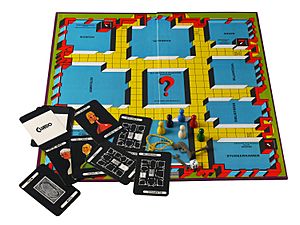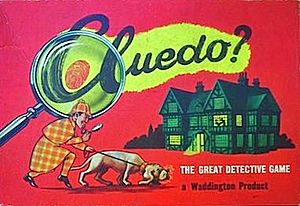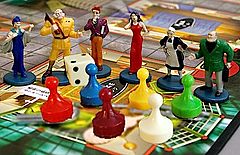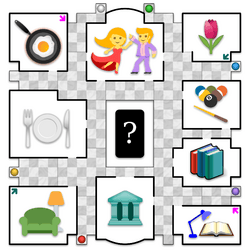Cluedo facts for kids
| The Classic Mystery Game | |
|---|---|

Dutch edition of the game
|
|
| Designer(s) | Anthony E. Pratt |
| Publisher(s) | Hasbro Waddingtons Parker Brothers Winning Moves Games USA |
| Publication date | 1949 |
| Players | 3–6 Players
2–6 Players (editions vary) |
| Setup time | 5 minutes |
| Playing time | 10 to 60 minutes |
| Random chance | Low (dice rolling) |
| Skill(s) required | Deduction |
Cluedo, also known as Clue in North America, is a super fun murder mystery game for three to six players. It was invented in 1943 by a British game designer named Anthony E. Pratt. The game was first made in the United Kingdom in 1949 by Waddingtons. Today, Hasbro, a big American toy company, owns and publishes the game.
The main goal of the game is to figure out three things: Who committed the crime? Where did it happen? And what weapon was used? Each player pretends to be one of the six suspects. You move around a game board that looks like a fancy mansion. As you play, you collect clues from other players to solve the mystery!
Over the years, Cluedo has become a huge franchise. There have been many other games, books, a movie, TV shows, and even a musical based on it. There are also different versions of the game with new characters, weapons, or rooms. The original game is known as the "Classic Detective Game."
In 2008, a new version called Cluedo: Discover the Secrets came out. It changed the board, how you play, and the characters. But many fans didn't like it. So, in 2012, Cluedo: The Classic Mystery Game was released. It went back to the original game style but added some cool new twists.
The Mystery Game: Cluedo/Clue
How the Game Began
During World War II, Anthony E. Pratt, a musician and factory worker in England, was stuck at home during air raids. He remembered playing murder mystery games at parties and loved detective stories, especially those by Agatha Christie. In 1944, Pratt applied for a patent for his new game, which he first called Murder!.
Soon after, Pratt and his wife, Elva, who helped him design the game, showed it to Norman Watson from Waddingtons. Watson loved it and bought it right away! He gave it the famous name Cluedo. This name is a mix of "clue" and Ludo, which is Latin for "I play."
Even though the patent was approved in 1947, there weren't enough materials after the war. So, the game officially launched in the UK in 1949. At the same time, it was licensed to Parker Brothers in the United States, where it was renamed Clue.
The very first idea for the game was a bit different from what came out in 1949. Pratt's original plan had 10 characters, 11 rooms, and 9 weapons. Some characters and weapons from his first idea, like Mr. Brown or a bomb, weren't in the first game. But some of these unused ideas later appeared in other versions of Cluedo.
Some rules were also different at first. For example, players had to land on another player to make a suggestion. But these small differences were changed for the game's first release. The main way to play the game has stayed mostly the same ever since.
Marketing the Mystery
When Cluedo launched in North America in 1949, it was called "The Great New Detective Game." They even made a deal to use the name "The Great New Sherlock Holmes Game." Advertisements suggested players could be like Sherlock Holmes. Later, in the 1970s, TV commercials showed Holmes and Watson playing the game. In the 1980s, the slogan became "Classic Detective Game," which is still used today.
In the UK, Cluedo was also called "The Great Detective Game" for a long time. For a while, the box covers even showed a detective who looked a lot like Sherlock Holmes.
Playing the Game
What's in the Box?
The game comes with a board showing a fancy English country house called Tudor Mansion. This house is in Hampshire, England, and the story takes place in 1926. The box also has:
- Colored playing pieces for each character.
- Small models of the murder weapons.
- Two six-sided dice.
- Three sets of cards: one for rooms, one for characters, and one for weapons.
- A special envelope (or a mirror in some versions) to hide the solution cards.
- A "Detective's Notes" pad to help players keep track of clues.
Meet the Suspects
The person who was murdered in the game is called "Dr. Black" in the UK and "Mr. Boddy" in North America.
Players choose one of six suspects to play as. These are usually plastic pawns or figurines.
The main suspects are:
- Miss Scarlett: She uses a red token.
- Rev Green: (or "Mr. Green" in North America). He uses a green token.
- Colonel Mustard: He uses a yellow token.
- Professor Plum: He uses a purple token.
- Mrs. Peacock: She uses a blue token.
- Mrs. White: She uses a white token.
In 2016, Hasbro changed things up! They replaced Mrs. White with a new character, Dr. Orchid, who uses a pink token.
The Crime Scene and Weapons
The weapon pieces are usually made of metal, except for the rope. Special editions might have fancier weapons, like gold-plated ones!
The weapons are:
- Candlestick
- Dagger (sometimes called a Knife)
- Lead Pipe (older versions had real lead, which was risky!)
- Revolver (a type of gun)
- Rope
- Wrench (also called a spanner in some places)
There are nine rooms in the mansion where the crime could have happened. They are arranged in a circle on the game board. Each of the four corner rooms has a secret passage that leads to the room on the opposite side of the board. The room in the very middle (often called the Cellar or Stairs) is where the solution envelope is kept, and players can't go into it. Each character starts on a colored space outside the rooms.
| † | Ballroom | ‡ | ||||||
| Kitchen | Conservatory | |||||||
| Dining Room | Cellar (with envelope) |
Billiard Room | ||||||
| Library | ||||||||
| Hall | ||||||||
| Lounge | Study | |||||||
| ‡ | † | |||||||
† ‡ denote secret passages to opposite corner
How to Play Cluedo/Clue
At the start of the game, three cards are secretly chosen: one suspect, one room, and one weapon. These cards are put into a special envelope. They are the solution to the mystery! The rest of the cards are then given out to the players.
Players choose a suspect token. In older versions, Miss Scarlett always started. Now, everyone rolls the dice, and the player with the highest roll goes first. Play then continues clockwise. Players roll the dice and move their token around the board, trying to get into different rooms.
The goal is to figure out which three cards are in the envelope. There are six characters, six weapons, and nine rooms. That means there are 324 possible solutions! When you enter a room, you can make a "suggestion." You name a suspect, the room you are in, and a weapon. For example: "I suspect Professor Plum, in the Dining Room, with the candlestick."
When you make a suggestion, the tokens for the suspect and weapon you named are moved into that room. Then, the other players try to prove you wrong. Starting with the player to your left, if they have any of the three cards you named, they must secretly show you just one of them. If they don't have any, the next player tries to disprove you. This continues until someone shows you a card, or no one can. Your turn usually ends after you make a suggestion.
If you think you know the solution, you can make an "accusation" on your turn. You can do this from any room. You secretly check the three cards in the envelope. If you are right, you show them to everyone and win the game! If you are wrong, you put the cards back and can't move or make suggestions for the rest of the game. You're out! If all players but one make a wrong accusation, the last player automatically wins.
Smart Moves and Tips
Choosing Your Character
When you start, think about which character to pick. Mrs. Peacock begins one space closer to the first room than others. Professor Plum can quickly reach the Study and then use a secret passage to the Kitchen, which is usually hard to get to.
Moving Around the Board
Try to get into new rooms often to make more suggestions. This helps you gather more information. Remember to use the secret passages! They let you jump across the board quickly. Sometimes, it's smart to move to a room even if you already have its card.
You can also use your suggestions to slow down other players. If another player is close to solving the mystery, you can suggest their character and move their token to a room far away from where they want to go. This can mess up their plans!
Taking Notes
Keeping good notes is super important in Cluedo! The game comes with "Detective Notes" to help you. You can mark off cards you've been shown. More advanced players also keep track of which cards other players *don't* have.
For example, if another player suggests "Mrs. Peacock in the Ballroom with the Candlestick," and someone shows them a card, you can try to figure out which card it was. If you have the Ballroom card and the Mrs. Peacock card, you know the other player must have shown them the Candlestick! This helps you narrow down the possibilities.
Different Versions of the Game
For many years, Parker Brothers and Waddingtons made their own versions of Cluedo. But in the early 1990s, Hasbro bought both companies. Now, Hasbro makes a single version of the game that is sold worldwide, with small changes for different countries.
Over its long history, Clue has had many different editions. The artwork on the boxes and the design of the mansion changed with each new version. But the weapons usually stayed pretty much the same.
Cluedo: Discover the Secrets
In 2008, Hasbro released a big update called Clue: Discover the Secrets. This version changed the board, characters, weapons, and rules.
The suspects got new names and backstories. Some weapons were removed (like the lead pipe), and new ones were added (like a baseball bat or poison). The rooms also changed names, like the Hall, Guest House, and Observatory.
There were also "Intrigue cards." Some gave you special powers, and others were "Clocks." If you drew the eighth Clock card, you were out of the game! To make an accusation, you had to move to the indoor swimming pool in the center of the board. This made it harder to win.
Many fans and critics didn't like these changes. They felt it changed the classic game too much. As of As of 2017[update], Hasbro no longer sells this version on its main website. However, a travel version of it still exists, which uses some of the new designs but plays like the classic game.
Clue/Cluedo: The Classic Mystery Game (Digital)
There's also a digital version of Clue/Cluedo made by Marmalade Game Studio. You can play it on iOS and Android mobile devices, as well as Steam and Nintendo Switch. It plays just like the classic board game, where you ask questions and take notes to solve the crime.
Special Editions
- Clue "Master Detective" (1988): This was a bigger version of the game! It had 12 rooms, 10 characters, and 8 weapons. You could play with up to 10 players. It added characters like Miss Peach and Monsieur Brunette, and weapons like poison and a horseshoe.
- Cluedo: 50th Anniversary (1999): This special edition came in a fancy box. It even let you play with an extra weapon: a bottle of poison!
- Clue "Nostalgia Edition" (2003, 2007): Hasbro released a retro version that looked like the 1963 game, often in a cool wooden box. In the UK, it was a re-release of the original 1949 design.
Worldwide Differences
The game has different names and small rule changes around the world.
In Canada and the U.S., the game is called Clue. This is because the British game Ludo, which inspired the name Cluedo, wasn't as well known there.
North American versions of Clue also changed "Reverend Green" to "Mr. Green." This is the only region that still does this. Other small changes include spelling "Miss Scarlett" with one 't', calling the spanner a wrench, and the dagger a knife (though the knife was changed back to a dagger in the 2016 U.S. edition).
In some countries, especially Spanish-speaking ones, the colors of the playing pieces might be different to match the characters' local names. Sometimes, even the rooms and weapons are changed! In Brazil, for example, the game is called Detetive.
See also
 In Spanish: Cluedo para niños
In Spanish: Cluedo para niños




